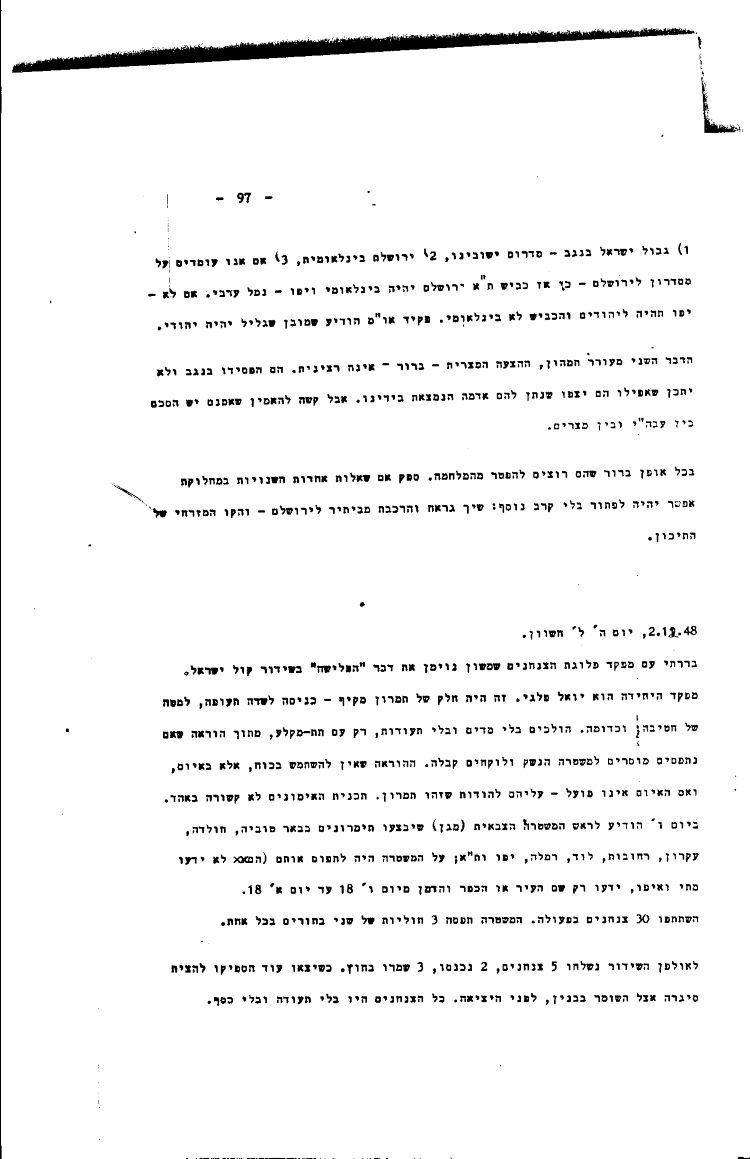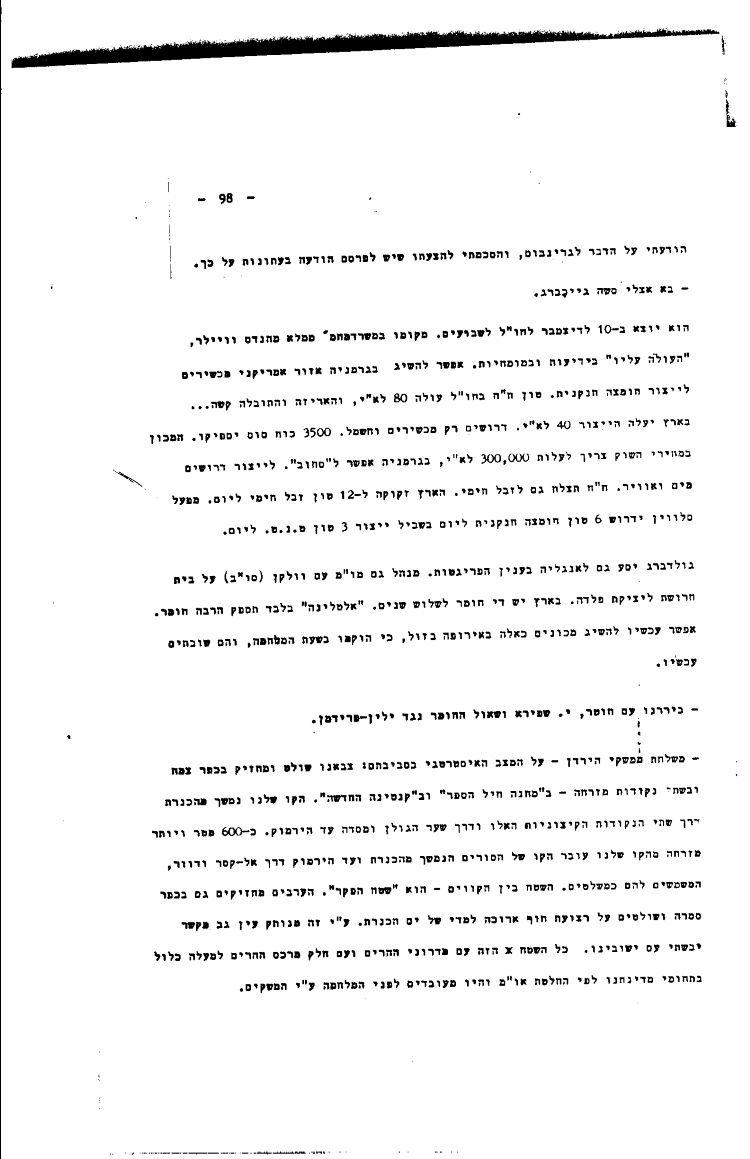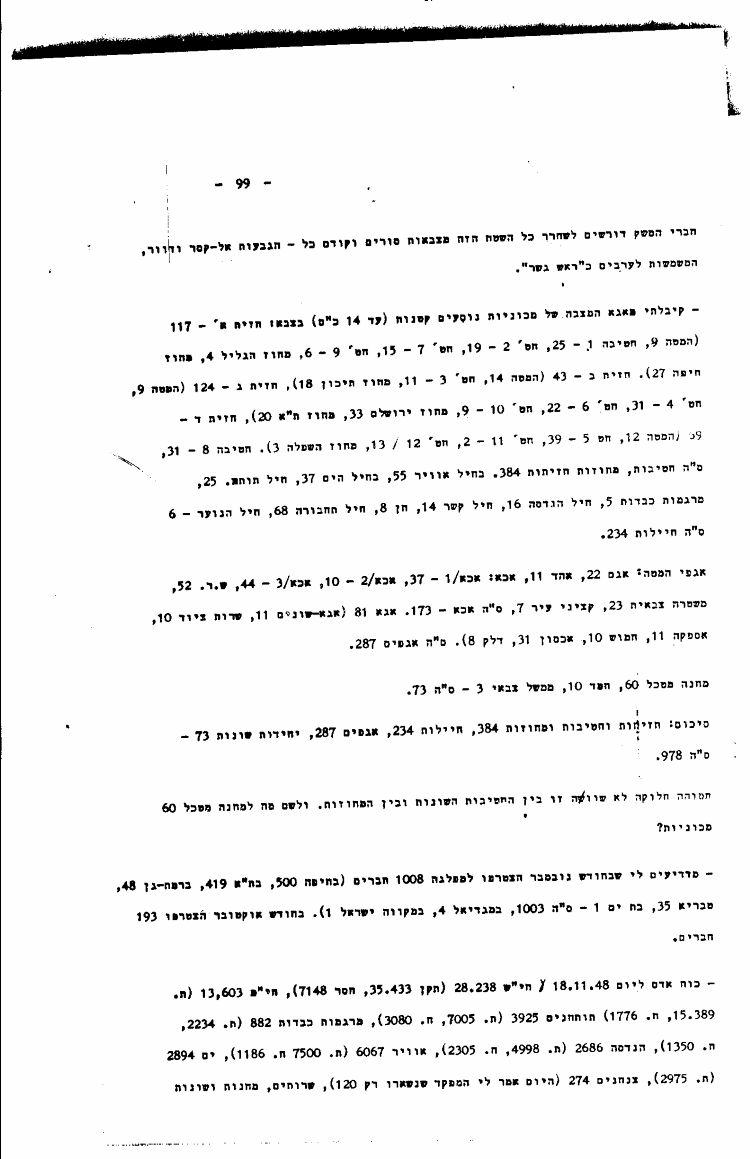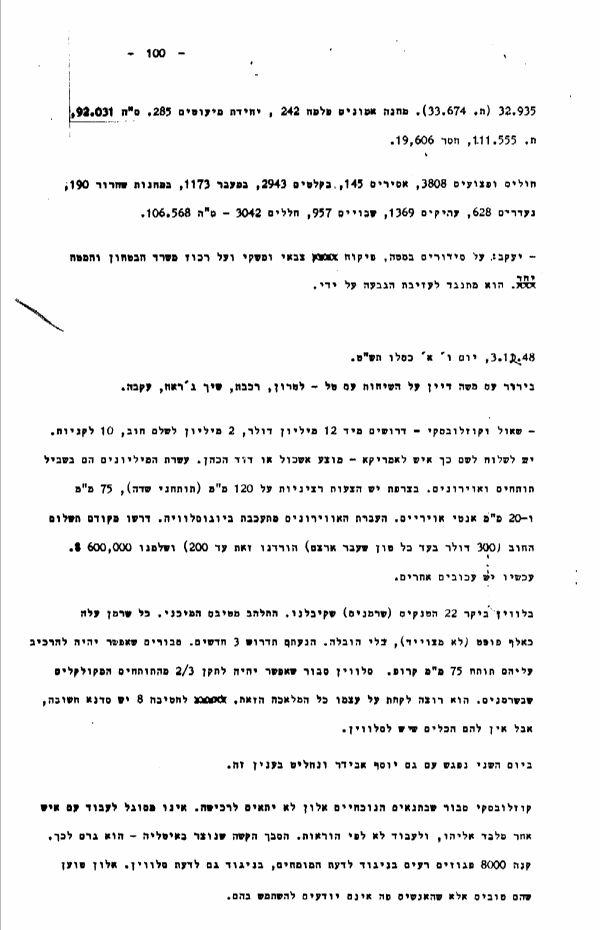Thursday, December 2, 1948
I consulted with the paratroopers company commander, Shimshon Neuman, regarding the "invasion" [they conducted] at the Kol Israel broadcasting [station]. The unit commander is Yoel Palgi. This was part of a comprehensive exercise: entry [penetration] into an airfield, a brigade headquarters, and the like. They go without uniforms and without documents, only with a submachine gun, with instructions that if they're caught, they give their weapon to the police and take a receipt. The instructions are: not to use force, but rather threat, and if the threat isn't effective - they must admit that it's an exercise. The training program isn't affiliated with the Training Department. On Friday [he] informed the head of the military police ([Danny] Magen) that they would conduct exercises in Be'er Tuvia, Hulda, ''Ekron, Rehovot, Lod, Ramle, Jaffa, and Tel Aviv; the police were supposed to catch them (they didn't know when or where, they only knew the name of the city or town and the time, from Friday [at] 6 p.m. through Sunday [at] 6 p.m.). 30 paratroopers participated in the operation. The police caught 3 cells of two men each.
5 paratroopers were sent to the broadcasting station, 2 entered, 3 stood watch outside. When they exited, they even managed to light a cigarette for a security guard in the building, before leaving. None of the paratroopers carried documentation or money.
I informed [Yitzhak] Gruenbaum of the matter, and I agree with his suggestion that an item about this should be published in the press.
- Sasha [Alexander] Goldberg came to see me. On December 10 he's going abroad for two weeks. His place in the RPCD [Research and Production Coordination Department] is being filled by [Julius] Weiler [sp.], who "surpasses him" in knowledge and expertise. Machines for the production of nitric acid can be obtained in Germany in the American zone. A ton of N.A. [nitric acid] costs P£ 80 abroad, and the packing and transport are difficult. In-country production would cost P£ 40. Only the machines and electricity are needed, 3,500 hp will suffice. The facility, at market value, should cost P£ 300,000. In Germany it's possible to "swipe." Production requires water and air. N.A. is also good for making chemical fertilizer. The country requires 12 tons of chemical fertilizer per day. Slavin's factory will require 6 tons of nitric acid per day to produce 3 tons of TNT per day.
Goldberg will also travel to England on the matter of prosthetics. He's also conducting negotiations with Vulcan (Solel Boneh) on a factory for steel casting. There's enough material in the country for three years. The Altalena [ship scraps] alone will provide a lot of material. Right now it's possible to obtain such facilities in Europe cheaply, because they were established during wartime, and now they're not operating.
- With Hoter[-Yishai], Y. Shapira, and Shaul [Avigur] we examined the material against Yellin-Friedman [Yellin-Mor, a LEHI leader].
- A delegation from the Jordan [Valley] settlements - regarding the strategic situation in their surroundings: Our army controls and has possession of the village of Samakh [Tsemah] and two locations to its east - the "Frontier Corps Camp" and "New Quarantine." Our line continues from the Kinneret [Sea of Galilee], through these two endpoints and through Sha'ar HaGolan and Massada, up to the Yarmouk. About 600 m farther east from our line is the Syrians' line, which extends from the Kinneret to the Yarmouk by way of Tel Qasr [Tel Katzir] and Dwier [Khirbet Abu-Dwier, at the opening of the Yarmouk Valley], which serve as strongholds for them. The area between the lines is "no man's land." The Arabs also have possession of the village of Samra [today - Kibbutz HaOn] and control a rather long strip of the Kinneret coastline. As a result ''Ein Gev has no land connection with our settlements. All of this area including the hill slopes and part of the mountain ridges above is within the territory of our state under the UN resolution and was cultivated before the war by [our] settlements.
The settlement members demanded all this area be released from Syrian forces, and first of all - the hills of al-Qasr and Dwier, which serve the Arabs as a "bridgehead" [at the foot of the Golan Heights].
- From the Logistics Department I received a service list of small passenger vehicles (up to 14 hp) in the army: Front A - 117 (the staff 9, Brigade 1 - 25, Br. 2 - 19, Br. 7 - 15, Br. 9 - 6, Galilee District 4, Haifa District 27). Front B - 43 (the staff 14, Br. 3 - 11, Tichon [Central] District 18), Front C - 124 (the staff 9, Br. 4 - 31, Br. 6 - 22, Br. 10 - 9, Jerusalem District 33, Tel Aviv District 20), Front D - 69 (the staff 12, Br. 5 - 39, Br. 11 - 2, Br. 12 - 13, Shfela District 3). Brigade 8 - 31, total for brigades, districts, fronts 384. In the Air Force 55, in the Navy 37, Artillery Corps 25, heavy mortars 5, Engineering Corps 16, Signal Corps 14, WC [Women's Corps] 8, Transport Corps 68, Youth Corps - 6, total for corps 234.
Staff Departments: Operations Department 22, Training Department 11, Personnel Department: PD/1 - 37, PD/2 - 10, PD/3 - 44, M.S. [Medical Service] 52, military police 23, city officers 7, total for Personal Department - 173. Logistics Department 81 (Logistics Department - miscellaneous 11, equipment service 10, supplies 11, ammunition 10, housing 31, fuel 8). Total for departments 287.
General Staff base 60, Science Corps 10, military government 3 - total 73.
In sum: fronts and brigades and districts 384, corps [including the Air Force and the Navy] 234, departments [within the General Staff] 287, various units 73 - total 978.
The unequal distribution between the various brigades and the districts is puzzling. And why does the General Staff base have 60 vehicles?
- I'm told that in November 1,008 [new] members joined the party [Mapai] (in Haifa 500, in Tel Aviv 419, in Ramat Gan 48, Tiberias 35, Bat Yam 1 - total 1,003, in Magdiel 4, in Mikveh Israel 1). In October 193 [new] members joined.
- Manpower as of November 18, 1948[:] Hayish 20,238 (standard 35,433, shortfall 7,148), garrison 13,603 (st. 15,389, sh. 1,776), Artillery 3,925 (st. 7,005, sh. 3,080), heavy mortars 882 (st. 2,234, sh. 1,350), Engineering 2,686 (st. 4,998, sh. 2,305), Air [Force] 6,067 (st. 7,500, sh. 1,186), Sea [Navy] 2,894 (st. 2,975), Paratroopers 274 (today the commander told me that only 120 remain), services, camps, and miscellaneous 32,935 (st. 33,674). Palmach training camp 242, Minorities Unit 285. Total 92,031, st. 111,555, shortfall 19,606.
Ill and wounded 3,808, prisoners 145, in intake [facilities] 2,943, in transit 1,173, at discharge camps 190, missing 628, deserters 1,369, POWs 957, fallen 3,042 - total 106,568.
- Ya'akov [Dori] on arrangements at the [General] Staff, military and economic oversight, and on bringing the Defense Ministry and the Staff together. He objects to my leaving the Hill [General Staff base in Ramat Gan].












